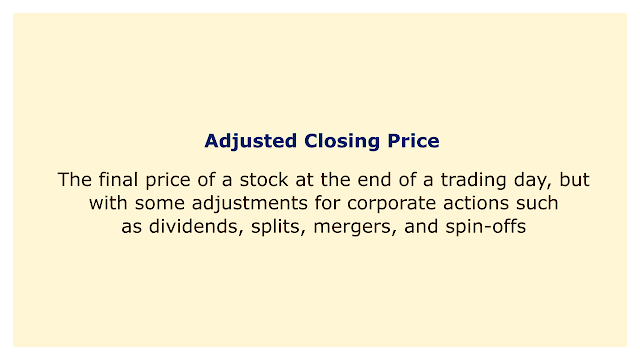 |
| Image: Moneybestpal.com |
The adjusted closing price is the final price of a stock at the end of a trading day but with some adjustments for corporate actions such as dividends, splits, mergers, and spin-offs.
These adjustments are required to reflect a stock's genuine worth over time and prevent deceptive comparisons between various time periods.
How is the adjusted closing price determined? The adjusted closing price is determined by dividing the initial closing price by a number that takes into account the corporate actions that have taken place since the initial closing date. The component is 1 - ($1 / original closing price), for instance, if a stock pays a dividend of $1 per share. The factor is 0.5 if a stock splits 2-for-1. When a stock merges with another business, the ratio of the new shares to the old shares becomes important. The factor in the case of a stock spinning out a subsidiary is the ratio of the parent company's market value to the sum of the two prior to the spin-off.
The adjusted closing price can either be determined manually using historical information on business actions and stock prices, or it can be found online through resources like Yahoo Finance, Google Finance, or Bloomberg. For each trading day, the internet sources typically offer both the original closing price and the adjusted closing price, along with the adjustment factors.
Although it is not ideal, the adjusted closing price is a valuable tool for stock market analysis. Inflation, taxes, commissions, fees, and other expenses that can have an impact on an investor's real return are not taken into account. However, it doesn't take into consideration variables like supply and demand, market mood, or other elements that could affect a stock's price in addition to its fundamentals. Investors and analysts should therefore use the adjusted closing price cautiously and in conjunction with other valuation indications and techniques.
How significant is the adjusted closing price? The adjusted closing price makes it easier for analysts and investors to evaluate a stock's performance over time, across various time frames, and with that of other stocks in the same sector or industry. The total return of a stock, which takes into account dividends and capital gains, can also be calculated using the stock's adjusted closing price. A more accurate way to determine how much money an investor has gained or lost from a stock investment is to look at the overall return.
How is the adjusted closing price determined? The adjusted closing price is determined by dividing the initial closing price by a number that takes into account the corporate actions that have taken place since the initial closing date. The component is 1 - ($1 / original closing price), for instance, if a stock pays a dividend of $1 per share. The factor is 0.5 if a stock splits 2-for-1. When a stock merges with another business, the ratio of the new shares to the old shares becomes important. The factor in the case of a stock spinning out a subsidiary is the ratio of the parent company's market value to the sum of the two prior to the spin-off.
The adjusted closing price can either be determined manually using historical information on business actions and stock prices, or it can be found online through resources like Yahoo Finance, Google Finance, or Bloomberg. For each trading day, the internet sources typically offer both the original closing price and the adjusted closing price, along with the adjustment factors.
Although it is not ideal, the adjusted closing price is a valuable tool for stock market analysis. Inflation, taxes, commissions, fees, and other expenses that can have an impact on an investor's real return are not taken into account. However, it doesn't take into consideration variables like supply and demand, market mood, or other elements that could affect a stock's price in addition to its fundamentals. Investors and analysts should therefore use the adjusted closing price cautiously and in conjunction with other valuation indications and techniques.
